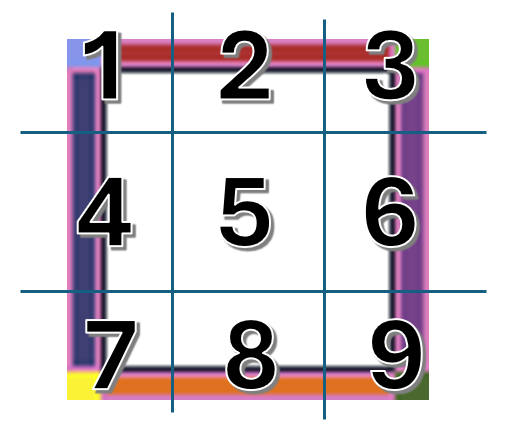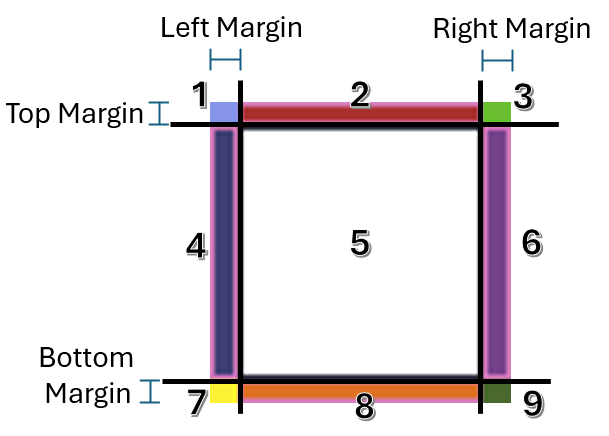Nine-Slice
🧪 Available in the v0.30.0 Alpha
Overview
The NineSlice is a Graphic which uses a 2D technique allowing for reuse of an image at various sizes without needing to prepare multiple assets. The process includes taking an input sprite texture, and splitting it into 9 sections, which then can be repainted in a new sprite texture without scaling or distorting the texture. This is very useful in game development for UI panels or buttons or textured platforms.
For example: let's say this is your source texture sprite.
The nine slice Graphic will break that texture up into 9 separate parts.

Then based on your output parameters specified it will 'redraw' this texture to whatever specified output graphic you want.
You can set parameters under sourceConfig properties to control the margins. This lets you dial in where the module 'slices' your texture up. For example, with the example 64 pixel x 64 pixel sprite, we can set the top/bottom margins to 5 pixels, and the left/right margins to 6 pixels to get this slicing.

Configuration
typescript
typescript
Usage
This is a Graphic object so it can be used on either an Actor or ScreenElement entity as a primary graphic, or as a part of a graphic group.
ts
ts
Stretch Options
There are two parameters in the configuration that need to be set to dictate the behavior of the drawing destination graphic, horizontalStretch and verticalStretch. They are of type NineSliceStretch. The horizontalStretch parameter will dictate the behavior of tile slices 2,5, and 8, as these frames can stretch horizontally. The verticalStretch parameter dictates how tile slices 4,5,6 behave, as they can stretch vertically.
The class includes some exported enumerated options:
ts
ts
Stretch
The stretch setting takes input slice and paints in across the entirety of the output dimensions, causing a stretching of the texture as its redrawn, but this is guaranteed to fit the designated area, just with some potential image distortion.
Tile
The tile setting takes input slice and paints in across the entirety of the output dimensions in a repeating texture fashion that will not distort the source image at all, but may not fit properly in the destination space, leaving a potentially partial drawing of the texture remaining.
TileFit
The tile fit setting takes the input slice and paints it across the entirety of the output dimensions in a repeating texture, but it 'resizes' the output tiling to create a 'best fit' of the texture, which is calculated to fit properly, but may have some squished and distorted texture.
Draw Center
ts
ts
The boolean flag drawCenter under destinationConfig tells the module if the section 5, middle section should be drawn or not, if this is set to false then it gets skipped in its draw routine, and remains 'transparent' so that the NineSlice is more of a border or frame Graphic.
Look, Ma! No Center!
Changing the Graphic
At this point, if you modify the graphic details, it is recommended to recreate a new instance of the graphic and update your Actor or Screen Element if it needs changed. The existing instance will not dynamically update itself.